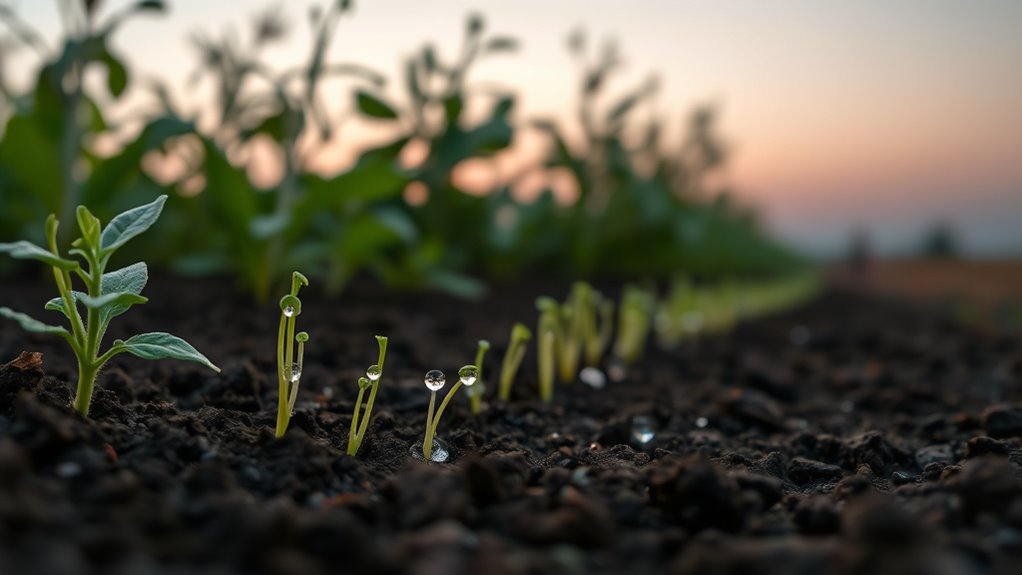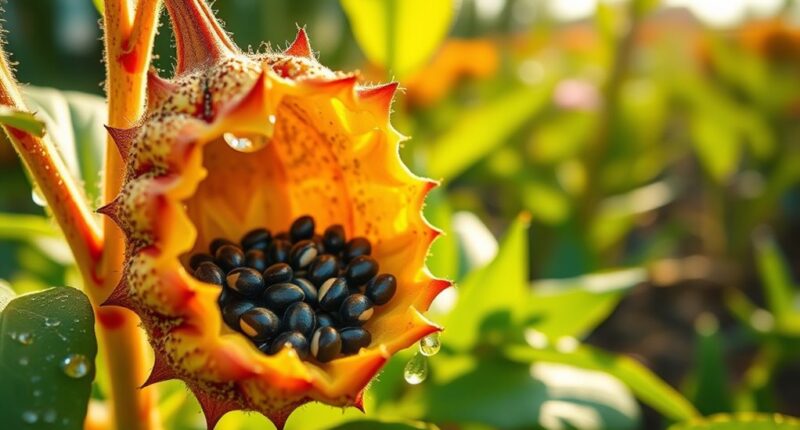Plant your chia seeds in early spring or late summer if you live in warmer regions, ensuring they avoid the hottest months. In cooler climates, wait until after the last frost date to give your seeds the best chance to germinate and grow. Timing depends on your regional climate, so understanding local conditions helps. Keep in mind that proper soil prep and watering are key—learn more to optimize your planting success.
Key Takeaways
- Plant chia seeds in early spring or late summer in warm regions for a fall harvest.
- In cooler climates, wait until after the last frost date in late spring.
- Ensure soil is well-draining, neutral to slightly acidic, and prepared with organic matter.
- Sow seeds on the surface or lightly cover with 1/4 inch of soil for optimal germination.
- Keep soil consistently moist during germination and early growth, adjusting watering as needed.

Knowing the right time to plant chia seeds can make all the difference in guaranteeing a healthy, bountiful crop. Timing your planting correctly depends heavily on understanding your region’s climate and the conditions that favor germination and growth. Before you sow, you should focus on soil preparation. Chia plants thrive in well-draining soil with a neutral to slightly acidic pH, roughly between 6.0 and 8.0. To set your plants up for success, loosen the soil and incorporate organic matter, such as compost, to improve fertility and moisture retention. This preparation guarantees the seeds have access to nutrients and a stable environment to sprout.
Timing planting based on climate and soil preparation ensures a healthy, productive chia crop.
Once your soil is ready, the next step is determining the most suitable planting season. In warmer regions with mild winters, you can often plant chia seeds in early spring or late summer for a fall harvest. If you’re in a cooler climate, wait until after the last frost date, which is usually late spring. Timing is vital because chia seeds need warmth to germinate effectively. Sow the seeds on the surface or lightly cover them with a thin layer of soil, about 1/4 inch deep, and keep the soil consistently moist during germination.
Watering schedule plays a key role in establishing healthy chia plants. Initially, you need to keep the soil evenly moist but not waterlogged. Overwatering can lead to seed rot, while underwatering can cause poor germination. Once the seedlings emerge, maintain a regular watering routine, ensuring the soil stays moist but drains well. As the plants grow taller, you can reduce watering frequency slightly but should still avoid letting the soil dry out completely. Consistent moisture encourages strong root development and lush foliage, both of which are essential for a good yield. Proper watering also supports seed germination and overall plant health.
Monitoring your watering schedule is especially important during hot, dry periods, as chia seeds and young plants are prone to stress from drought. Mulching around the plants can help retain soil moisture and keep roots cool. Additionally, consider watering early in the morning to minimize evaporation and provide the plants with the hydration they need throughout the day.
Frequently Asked Questions
Can Chia Seeds Be Grown Indoors Year-Round?
Yes, you can grow chia seeds indoors year-round. With proper indoor cultivation, you control light, temperature, and humidity, making it possible to enjoy year-round growth. Place your chia in a sunny spot or use grow lights, keep the soil moist, and guarantee good drainage. This way, you can harvest chia seeds any time, regardless of the season, by maintaining ideal indoor conditions for healthy plants.
How Do I Know When My Soil Is Ready for Planting?
Did you know that proper soil testing can increase plant growth success by up to 30%? To know if your soil is ready for planting, check its moisture levels—soil should be damp but not soggy. Conduct a soil test to assess pH and nutrients, ensuring ideal conditions for chia seeds. When the soil feels just right, it’s time to plant and watch your crops thrive!
Are There Specific Pests That Target Chia Plants?
You might wonder if pests target chia plants. While chia is generally pest-resistant, certain insects like aphids and caterpillars can occasionally cause issues. To protect your crop, choose pest-resistant varieties and use natural pest control methods like encouraging beneficial insects or applying organic pesticides. Regular inspection helps catch problems early, ensuring your chia plants stay healthy and productive without relying heavily on chemicals.
What Are the Signs of Overwatering Chia Seedlings?
Overwatering chia seedlings can be as damaging as underwatering, revealing itself through yellowing leaves, mold, or root rot. These watering issues threaten seedling health and stunt growth. If you notice persistent dampness, a musty smell, or slimy stems, it’s a sign you’re overdoing it. To protect your chia plants, guarantee proper drainage, allow the soil to dry slightly between waterings, and observe your seedlings closely for any signs of stress.
How Long Does It Take for Chia Seeds to Sprout?
You’ll see seed germination and sprouting time vary, but generally chia seeds sprout within 7 to 14 days. To encourage quick sprouting, keep the soil consistently moist and in a warm, bright spot. You’ll notice tiny green shoots appear as the seeds begin to sprout. Patience is key—once sprouted, your chia seedlings will quickly grow into lush plants, ready for harvest or further growth.
Conclusion
Now that you know the ideal planting times for your region, the question is—are you ready to start? The perfect moment could be just around the corner, waiting for you to take action. Will you seize the opportunity and watch your chia seeds flourish? Don’t wait too long—your successful harvest might depend on catching that sweet planting window. The next step is yours. Are you prepared to make it happen?









